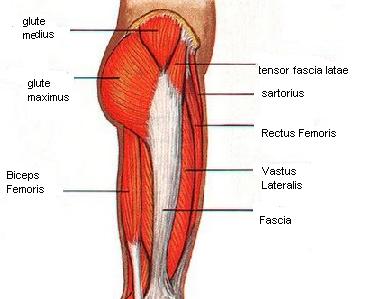After the blog post last week about IT Band Syndrome [1], several of you asked: “What are the best exercises to activate the glutes?” You ask, you shall receive.
Here is a brief review of the glutes and associated hip musculature. This will help with the exercise portion in a minute.
Definitions
- Abduction: leg moves out to the side
- Extension: leg moves back, behind body
- External rotation: leg rotates out and away from body
Glute maximus (glute MAX) actions at the hip:
- extension
- external rotation
- abduction (superior fibers)
It is active in 3 planes of motion and the main worker at the hip.
Gluteus medius (glute MED) actions at the hip:
- abduction
- stabilization (i.e. walking and single leg balance)
Tensor fascia lata (TFL) actions at the hip:
- abduction assistant
- internal rotation assistant
Notice the word assistant above. The TFL is just that, a helper. However, this muscle is almost always overdeveloped and dominant; it desperately tries to act as the main hip abductor when that is the role of the glute MED. Clinically, I am always looking for exercises that train hip abduction with minimal TFL recruitment.
Vastus lateralis (VL) actions at the hip:
- NONE!
This is the largest of the quadriceps muscles and it’s action is to extend (straighten) the knee. It has no attachment to the hip, except to say it communicates with the IT band. But, with dysfunction, the VL loves to help with hip abduction. One of the test positions to test glute strength is to have the patient lay on their side and lift the top leg. Most of the time, patients tell me they feel the outside quadriceps (VL) lifting their leg and not the glute MED. That’s a problem!

Glute MED, Glute MAX, TFL and VL
The following are two initial exercises I use to teach patients how to engage their glute MED and MAX effectively. They take a lot of brain power (remember the post about neuromuscular connections [2]), but they are low-load and easy to do without fancy equipment. Because they are non-weight bearing, they set the patient up for success to learn the muscle-movement connection without worrying about balance.
GLUTE EXERCISE #1: CLAM
This is a very popular rehabilitation exercise. I have likely given this to every single patient with a lower extremity or hip injury. But, I am super picky about how my patients do it.
Benefits of the Clam Exercise
- Leg on pelvis dissociation: teaches the leg how to move independently on a stable pelvis and trunk
- Sidelying core stabilization: lying on the side engages the core differently and requires increased oblique activation
- Decreases leverage of VL to abduct the hip: without the straight leg using IT band tension and VL, the glute medius is forced to begin working
- Glute MED, superior fibers of glute MAX training (minimal TFL): EMG (electromyographic) research proves that the clam BY FAR has a better ratio of activating glute MED and glute MAX, while limiting the activation of TFL. Above I mentioned that TFL is usually working too much and we are trying to chill it out. This exercise is PERFECT for that!
- Clam is significantly better at activating the glutes than lunges, squats and bridging. Something to remember!
CLAM EXERCISE: CORRECT FORM. Shoulders, hips and heels are in one line. Hips are flexed to 45º and knees are flexed to 90º. Lift the top left leg up while keeping the heels together and abdominals engaged. The leg moves independently of the body.
CLAM EXERCISE: INCORRECT FORM. The pelvis and trunk should NOT move with the leg, but this is the most common error with this exercise.
GLUTE EXERCISE #2: FIRE HYDRANT
Imagine a dog at a fire hydrant. Imagine how their hind leg lifts up. Have the visual? Moving on…
Benefits of the Fire Hydrant Exercise
- Triplanar motion of glute MAX (leg moving): extension, abduction and external rotation. It’s hard to find an exercise that incorporates all three!
- Glute MED stabilization (leg on ground): trains endurance of glute MED fibers
- Quadruped (on all fours) abdominal stabilization: this has a functional application (cleaning floors, picking up toys) and pre-plank muscle training.
FIRE HYDRANT EXERCISE: CORRECT FORM. The leg moves out and slightly back without compressing the lumbar spine. The abdominals and glute MED on the opposite leg (right leg in this video) stabilize the body.
FIRE HYDRANT: INCORRECT FORM. The weight should not shift over the stabilizing hip as shown in the video.
© 2014 and Beyond. ALL BLOG CONTENT at duncansportspt.com by Lori Duncan PT
ABOUT THE AUTHOR
 Lori Duncan, DPT, MTC, CPT is a respected Physical Therapist, Manual Therapist and Pilates instructor in Lafayette, CO. Lori is passionate about preventive physical therapy and education and is a nationally recognized presenter. She can be reached at [email protected]. You can also follow Duncan Sports Therapy + Wellness on Facebook [7] & Instagram [8] for more free tips and information.
Lori Duncan, DPT, MTC, CPT is a respected Physical Therapist, Manual Therapist and Pilates instructor in Lafayette, CO. Lori is passionate about preventive physical therapy and education and is a nationally recognized presenter. She can be reached at [email protected]. You can also follow Duncan Sports Therapy + Wellness on Facebook [7] & Instagram [8] for more free tips and information.
References: Selkowitz D, Beneck G, Powers C. Which exercises target the gluteal muscles while minimizing activation of the tensor fascia lata? Electromyographic assessment using fine-wire electrodes. J Orthop Sports Phys Ther. 2013;43(2)54-64.
Wanger T, Behnia N, Ancheta W, Shen R, Farrokhi S, Powers C. Strengthening and neuromuscular reeducation of the gluteus maximus in a triathlete with exercise-associated cramping of the hamstrings. J Orthop Sports Phys Ther. 2010;40(2):112-119.